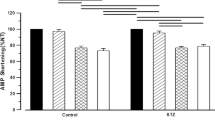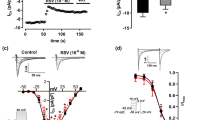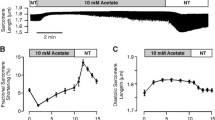Abstract
Alloxan is widely used to induce diabetes mellitus in experimental animals. Recent studies have provided evidence that alloxan has direct actions on cardiac muscle contraction. The aim of this study was to further investigate the mechanisms underlying the effects of alloxan on ventricular myocyte shortening and intracellular Ca2+ transport. Amplitude of myocyte shortening was reduced in a dose-dependent manner as the concentration of alloxan was increased in the range 10−7–10−4 M. Amplitude of shortening was reduced (56.8 ± 6.6%, n = 27) by 10−6 M alloxan and was partially reversed during a 10 min washout. Amplitude of the Ca2+ transient was also reduced (79.7 ± 2.9%, n = 29) by 10−6 M alloxan. Caffeine-evoked sarcoplasmic reticulum Ca2+ release, fractional release of Ca2+, assessed by comparing the amplitude of electrically evoked with that of caffeine-evoked Ca2+ transients, and fura-2-cell length trajectory during the late stages of relaxation of myocyte twitch contraction were not significantly altered by alloxan. The amplitude of L-type Ca2+ current was not altered by alloxan. Alterations in sarcoplasmic reticulum Ca2+ transport, myofilament sensitivity to Ca2+, and L-type Ca2+ current do not appear to underlie the negative inotropic effects of alloxan.






Similar content being viewed by others
References
Choi KM, Zhong Y, Hoit BD, Grupp IL, Hahn H, Dilly KW et al (2002) Defective intracellular Ca(2+) signaling contributes to cardiomyopathy in Type 1 diabetic rats. Am J Physiol 283:H1398–H1408
Bracken NK, Woodall AJ, Howarth FC, Singh J (2004) Voltage-dependence of contraction in streptozotocin-induced diabetic myocytes. Mol Cell Biochem 261:235–243
Howarth FC, Qureshi MA, White E (2002) Effects of hyperosmotic shrinking on ventricular myocyte shortening and intracellular Ca(2+) in streptozotocin-induced diabetic rats. Pflügers Arch 444:446–451
Ren J, Davidoff AJ (1997) Diabetes rapidly induces contractile dysfunctions in isolated ventricular myocytes. Am J Physiol 272:H148–H158
Okayama H, Hamada M, Hiwada K (1994) Contractile dysfunction in the diabetic-rat heart is an intrinsic abnormality of the cardiac myocyte. Clin Sci (Lond) 86:257–262
Garber DW, Everett AW, Neely JR (1983) Cardiac function and myosin ATPase in diabetic rats treated with insulin, T3, and T4. Am J Physiol 244:H592–H598
Garber DW, Neely JR (1983) Decreased myocardial function and myosin ATPase in hearts from diabetic rats. Am J Physiol 244:H586–H591
Vadlamudi RV, Rodgers RL, McNeill JH (1982) The effect of chronic alloxan- and streptozotocin-induced diabetes on isolated rat heart performance. Can J Physiol Pharmacol 60:902–911
Zhou BQ, Hu SJ, Wang GB (2006) The analysis of ultrastructure and gene expression of sarco/endoplasmic reticulum calcium handling proteins in alloxan-induced diabetic rat myocardium. Acta Cardiol 61:21–27
Howarth FC, Al Sharhan R, Al Hammadi A, Qureshi MA (2007) Effects of streptozotocin-induced diabetes on action potentials in the sinoatrial node compared with other regions of the rat heart. Mol Cell Biochem 300:39–46
Salem KA, Kosanovic M, Qureshi A, Ljubisavljevic M, Howarth FC (2009) The direct effects of streptozotocin and alloxan on contractile function in rat heart. Pharmacol Res 59:235–241
Wold LE, Ren J (2004) Streptozotocin directly impairs cardiac contractile function in isolated ventricular myocytes via a p38 map kinase-dependent oxidative stress mechanism. Biochem Biophys Res Commun 318:1066–1071
Patterson JW, Lazarow A (1949) Alloxan and dialuric acid: their stabilities and ultraviolet absorption spectra. J Biol Chem 177:197–204
Levi AJ, Hancox JC, Howarth FC, Croker J, Vinnicombe J (1996) A method for making rapid changes of superfusate whilst maintaining temperature at 37°C. Pflügers Arch 432:930–937
Spurgeon HA, DuBell WH, Stern MD, Sollott SJ, Ziman BD, Silverman HS et al (1992) Cytosolic calcium and myofilaments in single rat cardiac myocytes achieve a dynamic equilibrium during twitch relaxation. J Physiol 447:83–102
Lenzen S (2008) The mechanisms of alloxan- and streptozotocin-induced diabetes. Diabetologia 51:216–226
Pabbathi VK, Suleiman MS, Hancox JC (2004) Paradoxical effects of insulin on cardiac L-type calcium current and on contraction at physiological temperature. Diabetologia 47:748–752
Nakamura U, Iwase M, Uchizono Y, Sonoki K, Sasaki N, Imoto H et al (2006) Rapid intracellular acidification and cell death by H2O2 and alloxan in pancreatic beta cells. Free Radic Biol Med 40:2047–2055
Howarth FC, Qureshi A, Singh J (2004) Effects of acidosis on ventricular myocyte shortening and intracellular Ca2+ in streptozotocin-induced diabetic rats. Mol Cell Biochem 261:227–233
Harrison SM, Frampton JE, McCall E, Boyett MR, Orchard CH (1992) Contraction and intracellular Ca2+, Na+, and H+ during acidosis in rat ventricular myocytes. Am J Physiol 262:C348–C357
Orchard CH, Kentish JC (1990) Effects of changes of pH on the contractile function of cardiac muscle. Am J Physiol 258:C967–C981
Litwin S, Kohmoto O, Levi AJ, Spitzer KW, Bridge JH (1996) Evidence that reverse Na–Ca exchange can trigger SR calcium release. Ann N Y Acad Sci 779:451–463
Acknowledgments
Grant from the Faculty of Medicine and Health Sciences, UAE University
Author information
Authors and Affiliations
Corresponding author
Rights and permissions
About this article
Cite this article
Salem, K.A., Qureshi, A., Ljubisavijevic, M. et al. Alloxan reduces amplitude of ventricular myocyte shortening and intracellular Ca2+ without altering L-type Ca2+ current, sarcoplasmic reticulum Ca2+ content or myofilament sensitivity to Ca2+ in Wistar rats. Mol Cell Biochem 340, 115–123 (2010). https://doi.org/10.1007/s11010-010-0408-7
Received:
Accepted:
Published:
Issue Date:
DOI: https://doi.org/10.1007/s11010-010-0408-7




